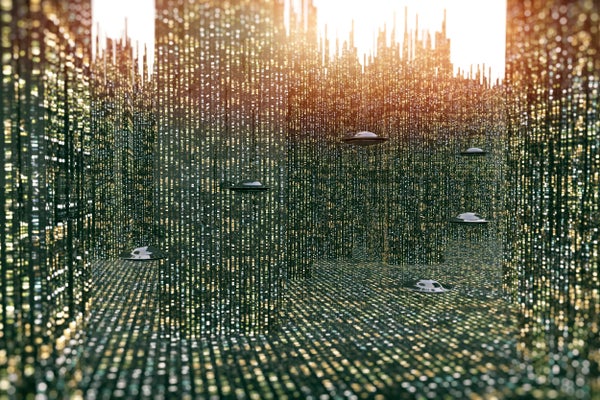About a decade ago, I attended a conference inaugurating the campus of New York University in Abu Dhabi along with a colleague from Princeton University, Ed Turner. The conference included a tour through the neighborhood, during which the local guide bragged that their city lights can be seen all the way from the moon. Ed and I looked at each other and wondered: from how far away could the Hubble Space Telescope (HST) detect city lights?
During the following day, we calculated that the Hubble Deep Field could notice a city like Tokyo on objects in the Kuiper belt at 30–50 times the Earth-sun separation. But can we distinguish artificial lights from natural reflection of sunlight if they have a similar color?
In answering this question, Ed and I stumbled across a key insight concerning the dependence of the observed flux on the distance of the light source. The flux of reflected sunlight declines inversely with the square of the reflector’s distance from the sun (regarding the sunlight intercepted by it) times the square of its distance from us (for the light we receive). For sources very far away, the product of these factors implies dimming inversely with distance to the fourth power. On the other hand, an artificial source that produces its own light acts like a light bulb and dims only inversely with the square of its distance from us. By checking whether a Kuiper belt object dims inversely with distance to the second or fourth power as it recedes away along its orbit, one can infer whether it emits its own light.
On supporting science journalism
If you're enjoying this article, consider supporting our award-winning journalism by subscribing. By purchasing a subscription you are helping to ensure the future of impactful stories about the discoveries and ideas shaping our world today.
Coincidentally, one of the leading observers of the Kuiper belt objects visited my office afterwards. I did not miss the opportunity to ask him: “Did you ever check how the brightness of Kuiper belt objects changes with distance along their orbits?” He replied without hesitation: “Why would I check? It must follow the dependence expected from reflected sunlight.” To which I could only say: “If you are not willing to discover wonderful things, you will never find them.”
But I am patient. Education takes time, especially when dealing with scientists. When I was asked recently how long humans can stay ignorant about nature, I answered that people can refuse to consider evidence that contradicts their convictions for millennia. This was the case regarding the notions that we are located at the center of the universe or that the outcomes of wars are dictated by planets and stars in the sky. The extent of our ignorance is unlimited. We could choose to stay uninformed forever, just like animals.
Admittedly, it is unlikely for a light source as bright as the city of Tokyo to exist in the outskirts of the solar system, unless it is associated with a giant spaceship passing by. But we could potentially search for artificial lights from habitable planets around other stars.
The closest is Proxima b, a planet in the habitable zone of our nearest neighbor, the dwarf star Proxima Centauri, which is located 4.25 light years away. Since the planet is 20 times closer to its faint star than the Earth is from the bright sun, Proxima b is thought to be tidally locked with permanent dayside and nightside (just as the moon faces Earth with the same side at all times). A technological civilization on Proxima b might opt to transfer heat and electricity from the warm, illuminated day side to the cold, dark night side. This could be accomplished, for example, by coating the dayside with photovoltaic cells that generate electricity out of starlight. In a paper with my former postdoc Manasvi Lingam, we showed that substantial coverage of the dayside by solar panels could be detected with future telescopes based on the spectral edge that they exhibit in their reflectance of starlight.
This raises an interesting hypothetical question. If the nightside of Proxima b is illuminated by artificial light, could we detect it with HST’s successor, the James Webb Space Telescope (JWST), scheduled for launch this year? Since JWST is bigger and more sensitive than HST, it would allow us to peer farther into space and extend the search for artificial lights from the Kuiper belt to habitable exoplanets like Proxima b. I explored this question in a new paper with an undergraduate student from Stanford University, Elisa Tabor.
We computed the light curve expected from a partially lit Proxima b as it orbits its star. Our calculations showed that JWST will be able to detect light emitting diode (LED) lamps on the nightside making up 5 percent of the stellar illumination of its dayside. But even if the artificial illumination is as faint as our civilization currently utilizes (0.01 percent) on the nightside of Earth, JWST could detect it as long as it was limited to a frequency band that is a thousand times narrower than the stellar light. Future observatories, like the proposed Large Ultraviolet Optical Infrared Surveyor (LUVOIR) space telescope, will be able to detect even fainter levels of artificial illumination on the nightside of Proxima b.
The search for city lights on habitable planets may sound speculative, but it is worth pursuing as a potential technosignature with planned instruments. Proxima b orbits its star every 11.2 days, providing 32.6 more opportunities for its possible inhabitants to celebrate their birthdays than we have on Earth, once per 365.2 days. The high demand for bright lights during birthday parties on the nightside of Proxima b would be a reason for us to celebrate as well, if the signal was noticed by future telescopes.
